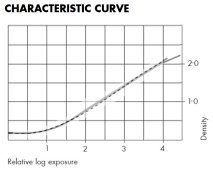I use T-Max and TX since the mid 1980s, and teaching darkroom technique in a high school.
That's neither an indicator of useful insight/ knowledge nor teaching ability.
Why do you want to ignore what Phil Davis has written on pp.154-155 of the BTZS Manual? After all, you expend thousands of words trying to force people to buy it.
Why do you cut the Graph at 2.0D man ? The shoulder shows beyond that. I paint two hypotetic shoulders compared to linear behaviour:
Irrelevant.
Do you accept that Kodak intends both films to have the same (short) toe characteristic?
Steve Sherman sent me his method and tutorials, after I analyzed for him some histograms to find technical conclusions about microcontrast effects in stand processing.
Personally, I'm pretty aware about the effects of minimal agitation, you state a pejorative "simplistic notions of the stand/ semi-stand brigade", you have to know that there was a lot of work in refining that technique, that it has very clear effects, and that an skilled photographer can take principal advatages from that technique in the situations it is suitable, of course not always by far. Sherman's gallery is self explanatory.
Sorry, but you show a deep ignorance about this matter.
Agitation methods have been very, very thoroughly analysed post-WWII at a level very far beyond what you or Steve Sherman can do - and the outcome was that emulsion construction techniques offered far greater potential for acutance/ speed/ grain improvement without problematic side-effects. If various stand techniques really achieved their claimed end results consistently and reliably, it would have been set in stone as standard technique by Kodak. That it works at all owes as much to emulsion designers allowing for bad agitation technique on the part of the end user as anything else. There have been films made that had to be machine processed because otherwise they would produce uneven results.


 you will have to compress highlights anyway, by burning with a low contrast filter, the 0 or the 00... if not HL textures won't fit with in the paper dynamic range. Because of the higher density in TMY you may have to extend the burning x2 or x3 times longer, delivering side effects to the sorrounding areas, or forcing an HLM job.
you will have to compress highlights anyway, by burning with a low contrast filter, the 0 or the 00... if not HL textures won't fit with in the paper dynamic range. Because of the higher density in TMY you may have to extend the burning x2 or x3 times longer, delivering side effects to the sorrounding areas, or forcing an HLM job.


